Does "Intern" Magazine Have Interns
Intern is going to be a print publication about… interns. And we think, by interns? And about, of course, interning. Ha, wow, that word is starting to look freaky. InTERN. INtern.
Hmm.
They’re Kickstarting right now, because that’s all editorial interns ever learned about business models. (WELL? I MEAN.) But they only want £5,500, so go on and lend a few quid.
But just think. A whole magazine of people to exploit. Sensual.
The Other Person Is You

All I had to do in Albuquerque was rent a car and drive away from the place. I had asked the people at the rental car place for the smallest, cheapest car possible, and the attendant described my choices to me, stressing that one of them was bigger but got better gas mileage, and so I said, sure, that one is fine, why not. When he handed me the bill to sign, I discovered that the car he had led me to choose was in fact $150 more than the other one. “That,” I said, pushing the list of charges back to him over the counter, “was so fucking lame.”
The attendant was about twenty-five, handsome, animated but blank. I wasn’t sure if he was gay or straight or if he even knew himself. He stared at his fingers as he retyped my order, and said, “That’s why we like to go through the whole thing first, to make you understand everything.”
“Oh my God,” I said. “You did not just really say that.”
“As I said, that’s why we like to go over everything right upfront, to make sure you’re understand everything.”
“You do know that it’s apparent that’s a script? I mean, I just want you to know that I know that we’re not actually communicating.”
“Well. That’s why we like to go over everything upfront…”
“Just admit you didn’t say that the other car was more expensive. That’s all I want. Just admit it.”
“Ok, you’re right,” he said. “I didn’t say that it was more expensive. I never said it.”
Then he flushed with shame. I felt good, like I’d just run a fast mile.
Then I drove 100 miles through the desert towards 2000 people and seven days of sleeping in a tent and getting up at 3 o’clock in the morning to meditate.
•
Yogi Bhajan is not the founder of Kundalini Yoga, but he is credited with bringing it to the west. He was born in the Punjab in 1929 and he died in Española in 2004. Kundalini and Kundalini Yoga both defy easy explanation, still here are some attempts, from Bhajan himself. “Kundalini Yoga is the technology of human consciousness.” Also: “Kundalini is known as the nerve of the soul.” (Is it?) “Kundalini Yoga is the fastest way to establish an aligned relationship between the body, mind, and the soul.” (What practitioner wouldn’t want to believe this?)
One of the first places Yogi Bhajan taught was a church in Altadena. Before going inside he would litter the parking lot with dollar bills so that people who didn’t have money could still come to class and still technically pay for it, since he felt it was important for people to offer him something. He loved movies. A friend of mine who grew up in the dharma (this means her parents were followers of his) was going through a rough time in her adolescence, and she and Yogi Bhajan had an emotional conversation. When it was over, he announced, “Now we will go the movies.” They saw Rush Hour 2.
Yogi Bhajan believed women should eat eggplant pakoras to help with menstrual irregularities and advocated a variety of mono diets. One involves days of eating nothing but melon. Another calls for days of eating nothing but avocado sandwiches on the toasted crusts of sourdough bread, which sounds delightful. He also believed that eggs made your pituitary gland spin the wrong way. Upon discovering that a student of his ate eggs, he made her some himself, adding a disgusting amount of salt, and she ate those, but never ate eggs again.
•
You camp at Solstice. It’s just what’s done.
I am a particularly terrible camper.
I borrowed my tent, and before I left, I put it up in my backyard in Nevada City, CA. Actually, a friend of mine put it up, and I pretended I was helping and that I understood what he was doing, but really what I learned from the experience was that I was just going to have someone at Solstice put up the tent for me, hopefully someone I could pay so as to not feel guilty about it, and that is exactly what happened.
Some people’s tents are beautiful. They bring beds and things to hang their clothes on. My tent was essentially a garbage dump that I slept in. Any time something was dirty or I didn’t know what to do with it, I just threw it under my cot. Some day I may master camping, this time, I merely endured.
•
The site of The Summer Solstice Sadhana Celebration is called Guru Ram Das Puri. It is 8 miles from Española up a rutted dirt road. The Solstice website directions say “PLEASE DRIVE SLOWLY AND CAREFULLY on this portion of your trip” and because my car — a Chevy Cruze — was so shitty, “SLOWLY AND CAREFULLY” were my only options. While I bounced along willy-nilly, I was passed from both fore and aft by speeding SUVs, nearly all which were driven by people wearing enormous white turbans. Each car sprayed me with pebbles. Clouds of dust rolled up all around my car, so thick I had to pull over. Viewed through the milky white filament of the slowly dissipating dust the surrounding landscape of dry yellow soil, scrubby green brush, and the dimming blue sky was so beautiful I almost forgot its visual enhancement was the result of such a dick move.
•
Guru Ram Das Puri is a 160-acre preserve of land in the Jemez mountains. On the land is a very large tent called the Tantric Shelter. It has a concrete floor and a high roof and stays cool and breezy under the worst conditions. The three-day long meditation called White Tantric Yoga will take place here, as will Sadhana. Meals are eaten in the Tantric Shelter sometimes, and the bigger teachers — Harijiwan, Guru Singh, Gurmukh — hold enormous classes here as well.
There are three main camping areas. Tantric Hill is known for being windy and crowded. The Water Tower area is known for being popular with families and also, for its proximity to a loud generator. The Valley is known for being more protected, quieter, and a bit mellower, but further away. This past Solstice I told a friend I thought the Valley had a jam bands vibe. He laughed out loud, so I guess it’s true.
There is also a tent, on one side of which food is served, and on the other side of which is a bazaar, where the kind of items one would think would be sold at a Solstice gathering are sold: yoga wear, yoga music, crystals, books, and spiritually profound jewelry, like malas, which are beaded necklaces used as meditation aids — rosaries for hippies.
At the edge of the property, up above a few acres of parking lot, are a few cabins.
•
There is a solstice diet, which was designed by Yogi Bhajan.
The Solstice Menu
Breakfast
2 Oranges
2 Bananas
Solstice Potato Soup
Lunch
HummusQuinoa
Tabouli
Dinner
Solstice Mung Beans and Rice
Beets and Carrots
Solstice Hot Sauce
Golden Milk
Yogi Tea
Naturally, the lines for the porta potties move along quickly.
•
Golden Milk is milk with turmeric paste dissolved in it, and it is served at night after White Tantric to ease muscles sore from long hours spent in meditation. This is what Yogi Bhajan had to say about turmeric: “There is nothing more effective than turmeric to clean your body and purify it. There is nothing more precious on this earth but turmeric. Turmeric, ‘haldi,’ it solves every problem which cannot be solved.”
I love Golden Milk. I go through stages where I regularly include making and drinking it on my daily to-do lists. I don’t know why I never follow through. I mean, since turmeric solves every problem that can’t be solved.
•
Temperatures during the solstice event were between 90 and 100 degrees. The sun felt like it was sitting on my head. A fire raged somewhere off in the distance — I never did figure out where North was, or anything else. The open space there reminds me of the water in Maine. It’s pretty, but all you can do is look at it. There’s no venturing into, no chance of consummation. I can appreciate New Mexico, but it doesn’t really move me.
The camping areas are fairly far from the Tantric Shelter and the food. So if you leave something in your tent, your options are to brave the landscape and get heatstroke or to spend the whole day with a sense of paralysis: “I can’t go on without x, I must go on without x.” At least this gives you something to talk about when you run into people. “My toothbrush/yoga mat/sunscreen/ is in my tent.” You’d be surprised how many times you can say that sentence in one day and preserve a feeling of self-pity.
•
Yogi Bhajan wrote a lot of poems and songs, or poem-songs really, that are principally in English. They are interesting documents. I made a joke that he used to sit around late at night getting drunk and writing songs to use in White Tantric Yoga but it didn’t go over so well.
One of the poem-songs used in our White Tantric Meditations contained the following: “Prosperity, Originality, causes Ick sound.”
I repeat: “Prosperity, Originality, causes Ick sound.”
So, you know what prosperity and originality are. I will explain “Ick sound.” Or I will try. Ick is a very important sound in Kundalini Yoga, which is all about sound. Ick is a sound of being, of identity, of strength. So. Though I understand how prosperity and originality cause Ick sound, I don’t know if I would have put that as directly as he did.
Luckily the woman sitting next to my White Tantric partner also thought “Prosperity, Originality, causes Ick sound,” was extremely funny. Every time we got to this part of the song she would start to howl and I would join in.
•
Japji was written sometime in the 16th century by Guru Nanak, the first of the ten Sikh gurus. It was written in Gurmukhi. It takes about twenty minutes to recite and what it mostly says is A. it is good to chant God’s name and B. you can’t comprehend how great God is so you need to chant his name and C. doing so is the only way you will really make any headway in life, so don’t bother trying to figure life out, really, it’s too complicated, so you should just chant God’s name.
I don’t believe in God, really, or maybe I do. Either way, metaphorically, that all makes a lot of sense to me.
If you are a strict Kundalini yogi you get up every morning at dawn, take a cold shower and recite Japji. Naturally this is done at Summer Solstice. At 3 a.m, a teacher from Los Angeles named Guru Singh who is a good teacher (yay) but made a couple really bad songs with Seal (boo!) walks around the camp with an entourage and a guitar, stopping in different sections of camp to sing a song called “Rise Up.” For the next half hour people make their way to the Tantric Shelter. Some are showered and dressed in pure white. Some are crusty and curled up in sleeping bags. Japji starts at 3:45 a.m. A man and woman recite it from the stage in alternate lines, and everyone reads along with them. Or sleeps.
Japji is a big topic of conversation at Solstice. “I missed Japji,” “I was late for Japji,” “I got there in the middle of Japji and the Tantric Shelter was already packed.” “Whenever I miss Japji my whole day is thrown off.”
The only experience I have ever had that made me believe in reincarnation involved Japji.
•
Kundalini Yoga is not the up-dog, down dog, wrap your leg over your head type of yoga that one associates with yoga, though there are rare moments in it that have that sort of flavor. More often, we are seated, or flat on our backs, and doing strange things with our arms and legs, and breathing in strange ways, or making strange shapes with our mouths. Here is a direction from a Kundalini yoga class that is not atypical: “Begin alternately bringing your palms in as if to beat your chest, but do not touch your chest.” Here is one that is more out there than usual, but would still not surprise a practitioner, “Lie down on your back and put your arms up to 90 degrees, holding your piece of fruit.” (At the end of it all, you eat your fruit.)
Another thing about Kundalini yogis: they don’t say hi to each other. We say Sat Nam. In emails, on the phone, passing someone. It’s both hello and goodbye. You just get used to it. Sat Nam.
•
There are fewer than twenty real toilets for men and about the same for women at Solstice. Other than this, you are supposed to go to the bathroom in the porta potties. There are probably about 150 porta potties at solstice. No one likes a porta potty even under the best of conditions, and six days of 100-plus degree heat is not the best of conditions. Everyone knows about not breathing in a porta-potty, but I have actually learned to block out the entire experience of using one, even while doing so.
•
The basis of Kundalini yoga is the recitation of mantras. The idea being that instead of saying to yourself the usual sorts of things that go through your head such as, “Holy shit, I suck, I am so worried about money/my relationship/dying, I’m stupid, I’m fat,” you might say the Mul Mantar, which roughly translates into God is great, you should say his name to show him that you are aware of his greatness, and, although this not explicit, to thank him for having provided you with mantras that are far more uplifting than your own. Here is a transliteration of the beginning of the Mool Mantra: Ek Ong Kar, Sat Nam, Karta Purkh….” It sounds nice, right? Certainly it sounds better than “I hate my job, I wish I was dead, I hate everything.”
One year at Solstice I went to Guru Dev’s class. Guru Dev is a big Kundalini guy, very smart, but unfortunately, and this is particularly true in the enormous Tantric Shelter, you can’t really understand a goddamn word he says. He’s just one of those deeply self-assured guys who is like, “Hey, I’m Mexican, I don’t care about speaking English like fucking Winston Churchill, and I mumble too, so just figure it out.” So I put myself right near a speaker and was giving it my best shot and would have been doing fairly well if not for a persistent and mysterious sound of tinny music. It was definitely some kind of spiritual music; I could make out sitars, drums, harmoniums. I thought it might be coming from one of the other tents but I realized after a few minutes that its source was actually the sequined rucksack of a very pretty young woman sitting in front of me. “Excuse me,” I said, “I think your iPhone is on.”
I waited for a look of concerned alarm. I waited some more.
“It’s my mantra,” she said.
“I’m sorry?” I said.
“It’s my mantra.” Her tone made it unnecessary for her to add the words, “you fucking retard.”
“Oh,” I said. “Ok.”
“I never turn it off,” she said. “Ever. Sat Nam.”
“Sat Nam,” I said.
•
Biggest no-no ever of Solstice: staying in the cabins.
The Adobe Cabins, set on a little plateau above the parking area, are a lovely deep brown shade with a cheerful turquoise trim, and from far away look magically sweet. But no one should be fooled, for they are the very chambers of hell. Each cabin is the size of a medium-size bedroom and houses eight people in four bunk beds that take up most of the space. I stayed in them last year because I was flying to Solstice from somewhere else and couldn’t very well lug camping equipment all over creation. When I arrived at my cabin two days into Solstice every one else had arrived and there was nowhere to put my stuff. Only two people in my cabin spoke English as a first language, and, when tensions run high, let me assure you, fluency matters. There was a woman from some country whose face and nationality I have forever blocked from my mind who had brought the most enormous suitcase I had ever seen, plus a giant box, and I hated her so much I would sneer at her every time I saw her. We finally had a showdown over her luggage, which I don’t mind telling you I won.
•
For the years 2013 to 2017, each Summer Solstice has a saying, or sutra, attached to it. This year’s was “Recognize that the other person is you.”
On his second day there, my friend Carey was putting out some of the enormous five-gallon coolers full of electrolyte drink that sustain solstice gatherers through the hot days. As he did so, there was a woman standing near him eating, and, to the best of his recollection, he gave her a brief, acknowledging glance and a smile. She said, “I really don’t like people staring at me when I’m eating.”
Carey said something to the effect of “I’m not staring at you,” and she said something to the effect of, “Yes, you were.” He left.
Later he said to me, “I will recognize that everyone at Solstice is me, except for her.”
•
In the bazaar I got a white, empire-waisted cotton dress which my friend Suraj quickly named “The Goddess Dress.” I also bought two raw chocolate drinks, a book of Kundalini Yoga kriyas called “Self-Knowledge” and a white piece of fabric patterned with gold thread which is currently in use as an emergency bathroom curtain. Here is a pathetic story: When I arrived at Solstice this year I said to myself smugly, “It is so funny that last year at Solstice I wanted a mala. I was in such a different place then. I can’t imagine wearing one now. I am not so susceptible to this bullshit.” Within twenty-four hours of being there. I was once again looking for a mala. I did not purchase a mala, but this is only because I couldn’t find one I liked. I am still actively looking.
•
The quiet hours of the camp are from 10 p.m. to 3 a.m.
My last night there, at around 10:15 p.m., someone was playing what I can only describe as a combination of Bhangra and Reggaeton, loud, over an iPhone. The worst part was they kept turning it off, and you’d think it was all over, but then, it would come back on. At around 10:30, as it re-started itself for about the fifth time, I shouted, “You’ve seriously got to be kidding me,” and someone else shouted “Yeah!” and it went off for good.
•
I had the following conversation about reincarnation at Solstice.
Me: I don’t believe in it, but I wish it were true.
Male yogi: Well it is, so don’t worry about it.
Female yogi: I don’t want to come back.
Me: You don’t? I do. I don’t want to leave. I hate it here sometimes, but I want to try again.
Female yogi: Not me. I’m done.
Me: You are? You’re really done?
Female yogi: I want to be with [a deceased relative].
Me: Oh, right. I forgot. Sorry. Did I tell you about my weird Japji experience? Where I already knew part of it, like had it memorized?
Female Yogi: Several times.
Me: That’s the only thing that’s ever made me believe in reincarnation. Anyway. Do you really think if I want to come back, I will?
Male yogi: It’s just the way it works, so yes, I promise.
Me: Alright. If you say so. I really hope you’re right. Even though I seriously doubt it.
•
The cornerstone of Kundalini Yoga is something called Sadhana. Sadhana refers generally to any practice that is done every day, more specifically, it refers to a set pratice done in the morning that consists of Japji, which takes about 20 minutes, about 40 minutes of a Kundalini Yoga kriya, a seven-minute recitation of a mantra referred to as “long ek-ong-kars” and five other mantras set to music. The whole thing takes two and a half hours, and ideally, one is supposed to do it every day. I once did it for forty days in a row. Many people have done that, and more, but not many people actually do it daily.
Two days into Solstice a friend of mine asked how I’d been, and when I said I’d been incredibly anxious lately, she shook her head and said in her thick Texas accent, “Have you been doing your Japji?” When I said no she looked very sorry for me. She said, “You need to restructure your brain chemistry. This is your sadhana now. I want you getting up at four a.m. Take a cold shower or at least, get some cold water on your spine. And then I want you reciting your Japji.” Then she promised me that after a week or two of doing it I would feel like a different person. It’s the kind of thing you hear all the time in the Kundalini Yoga world, and you think to yourself, “How can doing this weird thing possibly solve my problems? That is ridiculous.” But then you don’t have a better idea, so, you get up at 4 a.m and take a cold shower and recite Japji every day for two weeks, and you find yourself feeling much better, and you think, alright. Whatever. Fine. I’ll do it.
•
Yogi Bhajan was a Sikh. Consequently many of the practitioners of Kundalini Yoga are Sikhs. You can tell the difference between Sikhs and non-Sikhs because Sikhs wear turbans. In case you thought people just wore turbans for the hell of it, let Yogi Bhajan disabuse you of that notion. “When you tie the turban, that is when the cranial adjustment happens. All parts of the skull are pulled together, and they remain together. This gives you the cerebral power to work things out.”
•
There is a lot about Kundalini Yoga and White Tantric and Solstice that is very unbelievable. Does a turban really hold your brain together? Does one day of White Tantric Yoga really equal years worth of meditation? If you revolve your life around Solstice, as Yogi Bhajan says, will everything really be taken care of? I laugh at all of it, but I keep coming back, so I either believe it, or I want to.
•
One day I was wearing my Goddess Dress and walking with a friend when we spotted a woman coming towards us wearing the exact same dress. As she got closer my friend and I observed that whereas I was wearing the billowy white cotton yoga pants traditionally worn with such garments, she was only wearing underwear. As the girl passed, she called out cheerfully, “We are wearing the same dress!” My friend, in a whisper, completed her sentence, “except in mine, you can see my vagina!”
•
White Tantric Yoga is a day-long meditation done in pairs. These pairs are lined up, shoulder to shoulder, from the front of the Tantric Shelter to the back, in six or seven rows. (I should probably know how many because numbers are pretty important in Kundalini Yoga.) The “male polarity” (not necessarily a man) faces the outside of the Tantric Shelter and the “female polarity” (not necessarily a woman, though there are more women here than men and a lot of female/female pairs and not so many male/male) faces the inside of the Tantric Shelter. There is a facilitator who sits at the front of the room on a stage, propped up, pasha-like, on a pile of pillows. One of them has a lion’s face on it. The other ones are sort of non-descript, in wan pastels. One of my White Tantric partners has been hating the pillows for years and kept floating the idea of donating the money to replace them.
None of the meditations are easy, because sitting on the ground is not easy, but some are worse than others. For example, holding your arms out at a right angle from your body for sixty-two minutes is not easy. (I did about eleven, then raised them, then lowered them, as best I could. My partner, a 54-year-old Kundalini yoga teacher from Berkeley, had his up the whole time.) In another meditation, a fairly easy one, we pressed our partner’s hands over our heads, making a sort of tent shape, and sang the Donavan song “Happiness Runs.”
•
The 2012 Solstice was very large, too large, mostly due to a number of attendants who were either coming from or going to various Rainbow Gatherings or other similar festivals. These people were under the misapprehension that because there are people at Solstice in white who meditate to Donovan songs, there are also drugs here and people to do them with. While Solstice is a fairly welcoming occasion, there was valid concern that a crowd like this was perhaps not in the right place and could adversely affect the atmosphere should their numbers swell. The most recent marketing of the Solstice has emphasized the getting up at 3 a.m. part of the experience, and consequently this summer very few of this sort of attendee found their way to Guru Ram Das Puri.
•
Yogi Tea is served every morning after Sadhana. Here is a recipe for it.
Yogi Tea
1 Gallon Water
30 cloves
30 whole green cardamon pods
30 whole black peppercorns
1 large finger of fresh ginger, thinly sliced
5 sticks cinnamon
1 teabag, Black Tea
Milk and Honey to taste (optional)
1. Bring water to boil.
2. Add all spices except black tea bag. Boil 30 to 45 minutes Longer is stronger.
3. Finally, add black tea bag and boil another 5 minutes. The black tea is added last because it amalgamates the spices and sort of seals them. Also the tannins help assimilate the spices into the body.
•
You do not sleep very much at Solstice. On my last day there, a friend of mine came up to me and said, “You look so…” And I thought she was going to say “beautiful,” because, after all, I had been meditating for five days, but she instead said “tired.”
On the way out of the Guru Ram Das Puri parking lot to head back to Albuquerque, I backed my rental car into a fairly large rock. The side and the hubcap both sustained noticeable damage, and I was like, “Fuck, what was the point of all this? I look like shit and I just trashed my rental.” But when I dropped the car off, they didn’t notice anything. “You see?” a friend of mine who’d been at Solstice said, when I told her the story: “That’s the kind of luck you have when you start doing sadhana every day.” I made fun of this comment to my friends who don’t do yoga, but the truth is, I guess I totally believe there is something out there that knows that I get up at 4 o’clock in the morning and take a cold shower and recite Japji. If I didn’t, there’s no way I would do it. Sat Nam.
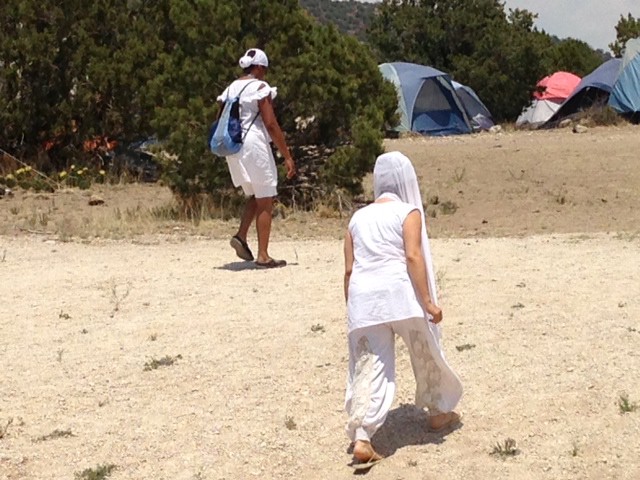
Sarah Miller is the author of Inside the Mind of Gideon Rayburn and The Other Girl, which were regrettably marketed to teens but should really be read by adults. She lives in Nevada City, CA.
Is This The Best Music And/Or Magazine Of 2013?
That was the bait, here’s the switch! *WHACK* Maura Magazine is off i-devices and into the wild today. CHECK IT.
A Global Guide to Airbnb Adjectives
by Becca Hafter

Airbnb, like the Fiske Guide to College, is rife with creatively employed adjectives. After all, not everyone’s studio can be “cozy.” And now, as New Yorkers are no longer allowed to let strangers use their apartments as makeshift hotels, European Airbnb hosts have cornered the weird-adjective market. Is the prose of European hosts touched by the cultural and economic microclimates tearing the European Union apart? Do their adjective choices shed light on the current political situation abroad? Is Google Translate to blame? Join me in a select alphabetical-by-city review of European Airbnb adjectives.
Athens
Athenian apartments are in the heart of the city, where guests can feel the urban pulse.
Barcelona
Roof, floor and other widely used architectural terms abound as adjectives in Barcelona.
Florence
Every apartment in Florence is quite luminous.
Lisbon
Typically, Lisbon homes are typical.
London
London flats are lovely, obviously.
Munich
Apartments in Munich are often zen and meditative.
Paris
Like the city itself, Parisian homes are charmant, charming and cute.
Prague
Apartments in Prague are retro, unless they’re newly renovated and modern but old concept.
Salzburg
Contrary to the musical history of the city, Salzburg homes are very quiet.
Stockholm
This is not an adjective, but it seems like every listed apartment in Stockholm has a sleeping loft.
What does it all mean?
Becca Hafter is an Awl summer reporter.
Is Your Standing Desk Killing You?

“Is there a better symbol of corporate obeisance than the standing desk? Set aside writers for a moment, whose work routines are relatively idiosyncratic. Of course the long, stationary workdays of most Americans are unhealthy. The solution should not be to sit less, but to work less. If sitting is as bad as the doctors say — and I’m sure it is! — then why not prescribe longer lunch breaks, shorter hours, and more vacation? You can still be chained to a standing desk. Is it any surprise that its biggest fans are the paternalist creeps of Silicon Valley?”
— Standing Desks: Where And When Will The Madness Stop? Unrelatedly, can we talk about how amazing and hilarious Shutterstock is? Why does this photo exist!
Photo by Elnur via Shutterstock
Louis Begley, Chuck Klosterman, Cathleen Schine, Alysia Abbott or Aisha Tyler?
Pick your literary pleasure! So many choices. But also, it is the 826NY comedy benefit at The Bell House, you should know. You can get tickets here.
'Wigwag' Revisited
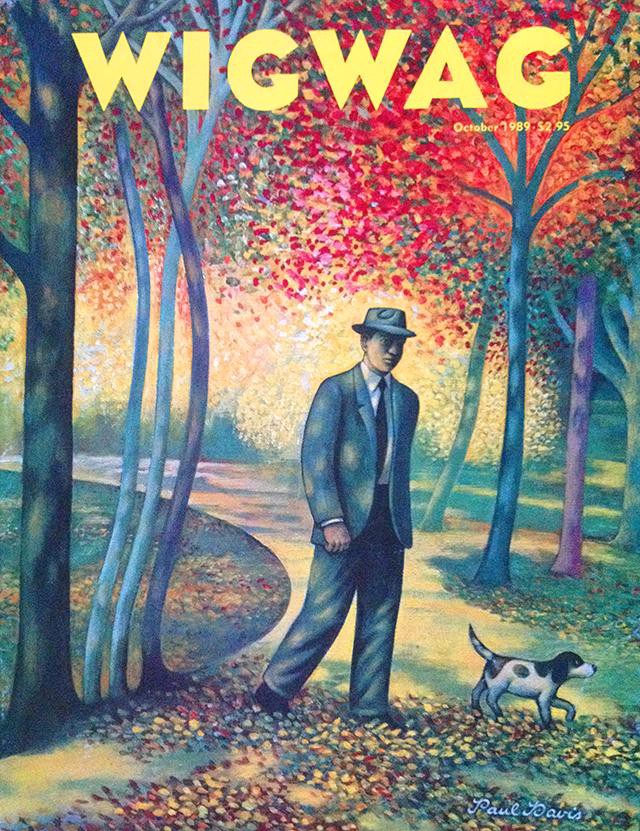
It was not a likely name for a magazine. A kid’s magazine, maybe, but a bold attempt to supplant the New Yorker? Eyebrows were raised. And yet Wigwag was launched anyway, in the fall of 1989. Editor Alexander Kaplen wrote in his introductory note: “The word isn’t made up, and the name’s no accident. This magazine has a lot to do with home — who lives where, what they do there, what they do there.” The definition, according to Kaplen, is, “to signal someone home.” Kaplen launched the magazine as a response to the ousting of long-time editor William Shawn in 1987 (detailed extensively by Elon Green last week). If Eustace Tilley was going to be co-opted by some outsider, then Kaplen was going to re-imagine that eminent magazine as one no longer the Talk of the Town (and you know which town), but rather the talk of all the towns, even the one in which you may live, be it Iowa City or Akron or Winnemucca.
Wigwag was apparently quite successful, reaching a circulation of 200,000, and was also well-regarded, at least until it ceased publication two years later.

I snagged a copy of the introductory issue, October 1989, on Ebay. (Not actually the first issue; there was a test issue a year and change earlier.) It’s in beautiful shape, and it’s a beautiful magazine, staple-bound, with thick low-gloss paper that they don’t seem to use anymore. The cover is an assured declaration of intent, no copy other than the title/price/date, a Paul Davis oil of a suited man, a small dog, an autumnal path through the woods. It is confident, a shot across the bow of That Other Magazine.
Inside, it favors artwork (art directed by Davis) over photographs, twining into the mission of homeliness (that of “being home,” not the other kind), with evocative, uniquely American illos by the likes of Maira Kalman, Gary Baseman and Elwood H. Smith. It’s artsy, it’s craftsy. The art is not just used as a splash to kick off a piece. Interior pages are bordered or cornered with these works, sometimes creeping across the gutter, sometimes swirling into a column of copy. It’s like a zine from the old days, but one that your successful, patrician grandparents would have produced.
And oh my God, the ads. Of course it was 1989, when magazines were enormously viable constructs at whom any advertiser would throw gobs of money, but when you flip through the upstart Wigwag, you see no difference between their ad pages and the advertisers you might have seen in Interview or Vanity Fair: Tanqueray? A Keith Haring Absolut ad? Stephen Sondheim for Amex? Two-page spread for the CD of the Month Club? A Smith-Corona, introducing “the world’s first laptop word processor?” All there. If there was anybody at the time concerned about the threat that Wigwag might hold to the New Yorker or anyone else in the high end of the market, the ad spends were no source of solace.

The geography of the interior of the magazine is a bit of an odd duck. According to the Table of Contents, your basic front-of-the-book is called POLITICS, then comes your FEATURE, then a palate-cleansing LETTERS FROM HOME, then of course FICTION, and THE ARTS at the end. Nothing ground-breaking, structurally, nor anything glaring, but there is a feeling that all the pieces at the front, middle and back could just be called SHORT THINGS and everything else IMPORTANT THINGS. This may be more about magazine publishing than it is about Wigwag.
The OED only partially confirms Kaplen’s definition of “wigwag,” agreeing that back and forth motion is involved, but failing to mention anything about home. Nonetheless, in the POLITICS section, there is some furious waving back and forth, thirty pages of ten short non-fiction pieces, none of them about politics.
Kicking things off is Indignities, a curation of obscure current events factoids, the sort of which that were later popularized into obstreperousness by the internet. A plumber in Oregon that wants to mandate AIDS tests! Oh, those plumbers! There is a listicle, or whatever they called listicles back then (the Wigwag Timeline!), a tart little illustration of men’s hat/necktie/show fashion over the history of the U.S. There’s some light comedy (a single shout, a handful of murmurs), there’s a profile of a preparator from the American Museum of Natural History. Where is she now, I wonder? Is her appearance in a twenty-something-year-old magazine worth disturbing her anonymity with a Google search? There is a piece by the first of the bold-faced name contributors, theater critic John Lahr, discussing the then-current embrace by the London establishment of playwright Arthur Miller and his observation of the decline of theater and everything else to a group of British intellectuals that would actually listen to him.
An essay by Suzanne Mata about parenting, about the rebellious teens of the time, is a nifty little snapshot of 1989. Mata’s daughter, roughly twenty years old, was no longer rebelling against the mother, but rather against the state. This particular daughter was active in ACT-UP in New York City. So banners are made (SILENCE EQUALS DEATH), and Mom tags along to a street protest, at which daughter and her compatriots are arrested and strip-searched down at the Tombs. It’s a brave new world, and the next generation is organized and committed to keeping it that way. It’s very Occupy, twenty years before Occupy invented themselves.

Closing out the front is a very fabulous bit of visual representation of data called The Family Tree, intended as a recurring bit. This one is a history of the American sitcom as indicated by the interlocking careers of the writers/producers up to that point. There are over fifty such talents included, and each is tracked via a different line, rendered in what looks to be colored pencil. All of the greats are there, from Mel Brooks and Buck Henry to James L. Brooks (no relation) to “new kid” Linda Bloodworth. I spent a good fifteen minutes digging into it. If you’re any kind of student of the field, it’s invaluable, and noteworthy for one omission (Susan Harris’ “Soap,” although her husband Paul Junger Witt is included), and one inclusion (Samuel Beckett) (!!).

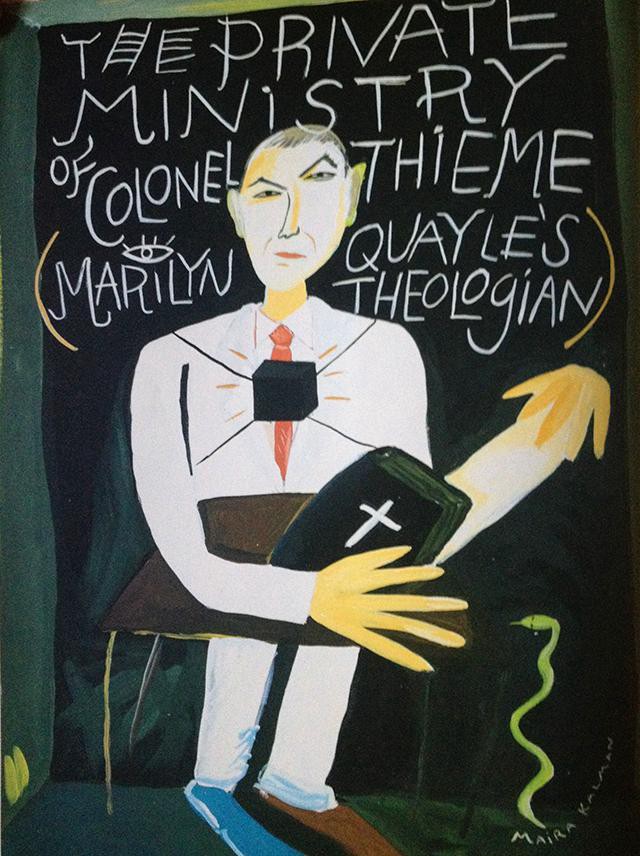
The sole feature story, helpfully labeled THE FEATURE, is by Gary Wills, already a winner of the National Book Award for Nonfiction, later to nab a Pulitzer for Lincoln at Gettysburg. It is titled “The Private Ministry of Colonel Thieme (Marilyn Quayle’s Theologian).” This had some newsworthiness at the time, as Marilyn was the husband of Dan Quayle, the then-vice president, who was a punchline then, and has since risen to the level of time-worn punchline with some progeny who are currently active but not quite elected (son Rep. Ben Quayle lost a redistricting primary in Arizona to David Schweikert last year.) The blurb is more a spoiler than a teaser:
Last fall rumors surfaced (and were quickly squelched) that Marilyn Quayle and her family were under the influence of an evangelical preacher who communicated with them through tapes, that they had listened to him every week, that he was something of a nut. But nobody would talk — not the Quayles, not the minister. GARY WILLS has interviewed him, and reports that the rumors were true.
Well for heaven’s sake why read? Because, getting there is all of the fun. Robert B. Thieme, Jr. was a controversial evangelist of the day, one that insisted that the proper way for his flock to worship was to listen, either in person or via the distribution of tapes, to his preachings. Nothing like your Bakkers or Falwells at all. He was rumored to be a favorite of the Quayles, specifically Marilyn Quayles’ parents.
The story is a bit of a bait and switch. If you’re reading for deep insight into the Quayles, you came to the wrong place. But it is a rigorous examination of the career and teachings of Thieme. Wills had an obvious familiarity with public religious (Christian) figures of the time, and tortures through the writings and speaking of Thieme (“pedantic lectures on dogma”), with whom Wills obtained a rather exclusive interview in the presence of Thieme’s phalanx of sycophants. “But he is an intellectual phony,” Wills writes, and then goes on to prove it. But the ties to the Quayle family, then a comical irrelevance, and now an historical one, were noticed but not mined. I’m sure that at the time the Christian fundamentalists were scandalized by the harsh light shined on Thieme, but the Quayles, with visions of a run after the elder George Bush’s second term, were breathing all sorts of sighs of relief.
Thieme passed away in 2009. Dan Quayle, of course, went on to be what he is to this day: Dan Quayle.

Now we come to a LETTERS FROM HOME, illustrated with rustic pastel cartoons dotting the pages. It’s five dispatches from the correspondents, far-flung across the nation. Most striking is Carmen Delzell from Baltimore, with a sweet tale of a middle-aged landing in Charm City and the handyman who raises her eyebrows, but there’s also a barroom conversation with bank examiners on the road in Lewisburg, WV, and something about the Armenians of Los Angeles. The clear anachronism (looking back) is Mary Norris in Astoria, with a meditation on donut shops and Weight Watchers that would have many firing up the time machine to slap a Trigger Warning on that sucker. But at the same time: it’s 1989. Weight Watchers was a thing then. Also, Cathy was a popular comic strip. Them’s the times that was.
And note that none of the cities chosen are Manhattan. The entire endeavor is deliberately blind to the media capital of the world, an effort not just to take on the New Yorker but also New York in general. Wigwag could as easily be called Flyover.
Now that we’ve confirmed that there is an America outside of Gotham, we arrive at the FICTION section, a must if a magazine wants to make weight to punch with the likes of the New Yorker. The first piece is a sort of a how-to on child-rearing from Daniel Menaker entitled “Bedtime Story.” Menaker was at the time a fiction editor for the New Yorker — intrigue! The piece is entitled “Bedtime Story” and it is just that, a story that one tells one’s child at bed time, incorporating the events of that day, subtly engineering one’s child to be mannerful and obedient. The longer story is from Jacqueline Carey (no, not the historical fantasist, but rather the author of short stories, partner of Ian Frazier). It’s called “Saving Fern,” and it’s a light, stylish tale of two 30ish women from the city traveling to friends’ upstate to rescue/not rescue another friend, a Manic Pixie Dreamgirl prototype. Neither jump out as a William Maxwellian attempt at Quality, but both are quite good.
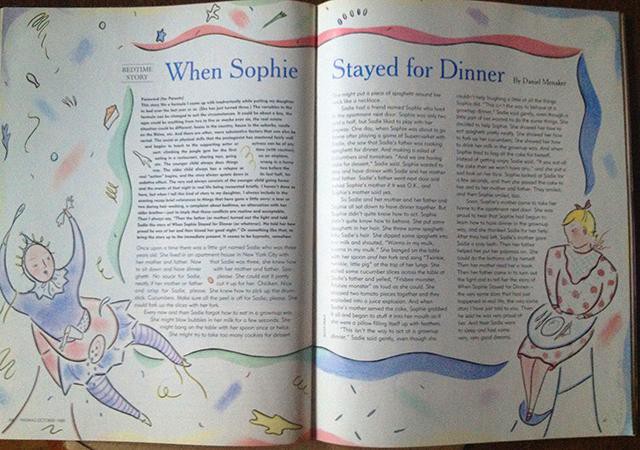
(There are poems too. I read them. Even a Robert Pinsky!)
Finally we arrive at THE ARTS, filling out the end pages of the magazine, though not all of the subjects are technically the Humanities. Edward Hoagland introduces himself as the book reviewer with a nice piece on a sixteenth-century chronicler of Cortez’s conquest of the Aztecs, Bernal Diaz. But then there is a rambling effort under the heading Great Outdoors about a park in Westchester, and another rambling sports piece, redolent of Roger Angell, which purports to introduce the quirky new game called “baseball” to an unaware public. The food column nicely anticipates the hipstervore ragnarok that would come to pass by singling out American artisanal cheese as nowhere near stinky enough, thanks to a national culinary prudishness. The Architecture column is a winner, as Witold Rybczynski reconsiders the design of the suburban home and the picture window, with a special guest appearance by Frank Lloyd Wright. And for music, an appreciation of the resurgence of then-62 year old Tony Bennett stands out mostly for the curious typo of the incongruous former labelmate of Bennett, the band “Arrowsmith.”

Wigwag is an artifact of a past era. (It is impossible, now, not to think WigWag as the actual name.) It’s dog-eared in places, but it was ambitious and distinctive, and it was assertive of its purpose. It was like the New Yorker (and how could it not be, with a masthead and contributors full of then-present and future New Yorker staff), but it was trying to devise an aesthetic that was inclusive instead of exclusive, that was purposefully national in its breadth.
Of course, when reconsidering Wigwag, the invisible elephant in the room is not so much the New Yorker as it is one other magazine launched in the late 80s, and one that you’ve definitely heard of: Spy. Spy began a few years earlier, in 1986, but they both met unfortunate, early demises. (Wigwag at least went out with a crowd, in 1991: 7 Days had just been shuttered after only two years, and Forbes closed Egg in 1991 as well.) The influence of Spy as the birthplace of snark is undeniable, but Wigwag had its echoes too, mostly in design. (Back in 2008, Designing Magazines made the case that the “specific visual language” of Spy influenced New York, Vanity Fair and Radar, but from here in 2013, that may be look like something of an evolutionary dead end as well.) But where Wigwag was soft and rounded, Spy was angular and rakish, and it was that nattiness that survived the first Iraq War and the bad economy that followed it, until at last in 1998 it expired for good as well — the same year that Omni was finally done.
The backpage feature of Wigwag is called MAP, and its intention was to have readers submit a little map of their life’s journey, in this case, for a woman named Linda Warner, from Seattle to Maplewood, NJ. Wigwag may be largely forgotten, but magazine publishing did definitely pause there for a brief time as the 80s bled into the 90s.
New York City, June 8, 2013

★★★★ Comfortable air blew down the subway steps in the dry, bright morning. Even so, out on the sidewalk, the feet drifted into the narrow shade of the awnings. The afternoon clouds were mounded in lumps like an excess of shaving foam. Tiny black helicopters hovered against the grayest patch, far downtown. A bird sang elaborately somewhere over Grand Street, against the blinding late sun. A huge dark fly squatted on the baby Shanghai bai cai. In the middle of dinner, the light outside the window suddenly turned strange and yellow: skeins of heavy rain were unwinding in full daylight; rain embroidered golden lines of stitching on the glass. The north was dim and bilious, but the western sky was clear almost to the zenith, the sun descending in a lavender glow.
Four Great North Carolina Musical Artists
by Resita Cox
Far from the big labels and high-priced venues of New York and L.A., bands and solo artists are forming their own business and audience opportunities. It’s not really unlike the old days — but now you don’t need the critical mass of an Athens or a Seattle scene. In addition to club shows and local tours, there’s a chance to grow up or even break out on the Internet. Here’s a guide to four strong and hungry acts working and playing in North Carolina.
1UP
“Swing the gas mask like an elephant trunk/then dunk/ the whole beat/ in a O-Z /of somethin’ skunk/Then I said what’s up/They say my ish was downloaded /promoted/ Hella dope so they tote it/” –J. Rowdy
In modern hip-hop, just about any artist can make a club banger, but where most fall apart is lyrical substance. 1UP can combine lyrics and beats that can stimulate your mind while still creating a song that will bang at any club scene. “1UP consists of two individuals that aren’t in the rapper norm, but decided that this is what they want to do,” said 1UP member (J) Rowdy. “We are finding our own lane outside of what, generally, hip-hop is.”
Rowdy and Cayso formed 1UP during their undergraduate years at UNC. The duo has climbed rap stairways; they were nominated this year for a Carolina Music Award. They’re on their own label, No9to5 Music, which includes five other artists and producers.
“Right now we are more than just internet rappers,” Rowdy said, “but we are not quite on the forefront. We are making our way towards the underground. This is what we do and people understand that now.”
The duo performed their first large show in Raleigh, NC. The show they’d previously performed was in a driveway. Rowdy said the experience was nerve-racking. “From a driveway to Lincoln Theatre, thats rather big,” Rowdy said. He describes their sound as “abstract 90s pop culture music.”
“We decided on 1UP as our name because, of course you have the video game concept of 1Up, but we literally wanted to 1Up everything we did,” Rowdy said. “Every single expectation we have, we want to 1Up it. 1Up is always about taking what you have and pushing your limits.”
Matt Phillips & the Philharmonic
Matt Phillips & the Philharmonic are southern musicians with a soft spot for jazz and folk. “We like to call it pop music because the goal is to make music people like — not that will sell, but what people will like,” Phillips said. Influenced by Jason Mraz, the band makes live studio recordings to preserve a natural sound.
“We had originally discussed doing a stacked record where you go in with one instrument at a time but our producer said, well, you guys sort of have this thing that when you play together, you just have a better sound,” Phillips said. The foursome came together during Phillips’ undergraduate years at East Carolina University. They recorded their first EP last summer; an EP that Phillips said they now hate. They are now working on their debut album with Manifold Recordings.
“There is a swing jazz track, folk tracks, Latin tracks, so this is really a big project for us and it has really made us a band,” Phillips said.
Their song “Olah” tells the unfortunate story of when Phillips started dating a married woman. “The song is very funny and has a lot of goofy things that were involved in my interactions with her,” Phillips said. “It’s a really straight up folky tune. This song demonstrates a lot of our fun vibe.” Phillips said his favorite stage was a small art gallery/coffee shop called Tipsy Tea Pot in Greenville, NC. “But it doesn’t matter where we play, these guys are my best friends and I enjoy every time we play,” he said.
Learn how to get your music heard at ReverbNation.com
Star Studies
Star Studies is a cross of country, blues and folk with a pop filter. The four guys used to call themselves Band of Fools — but grew out of that name. The band aspires to incorporate all of their musical backgrounds into one sound: “We are big in the blues; we are big on the classics; we love John Mayer,” the band said. “We all grew up listening to pop music too. We all brought a lot of different musical backgrounds.”
The band formed last year and has released one single, and will be releasing their second single soon. “I say that right now we are working really hard towards putting out this EP and we are really looking forward to it,” the band said. “We plan on doing this long term.” They’re also putting out another single this summer.
JSWISS
JSWISS got his nickname in fifth grade, after the shoe KSwiss, and he’s been writing since the age of 12. He’s also on No9to5 Records. He works in the lineage of a lot of “positive” rap, but also doesn’t mind rapping about cars. “I feel like all of my lines have wordplay and it’s like a double entendre, but nothing that goes over your head and it’s still a hot line,” JSWISS said. “There are a lot of rappers that use that wordplay, but they do it so much that it goes over your head. What I like about my lines is that you can catch it on the surface level as well as in the deep complex way.”
He called his LP “Awthenticity.” “The idea behind Awthenticity is that keeping it real has lost its meaning. If you don’t fit in to what’s ‘real’, then it’s not real,” he said.
And he’s not afraid to go big. “Right now I am in the underground. I’ve had some visibility and good looks but I’m really taking it to the next level where if you know hip-hop, you know JSWISS.”
Resita Cox is an Awl summer reporter.
Inside The Chive
by Jordan Larson
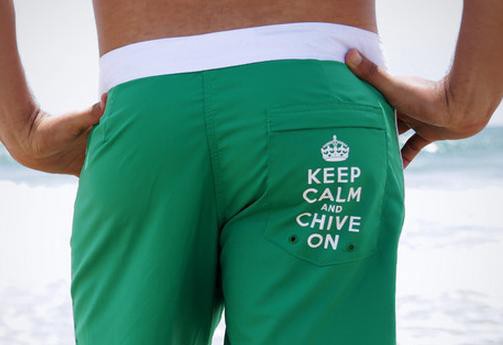
If you spot a Chiver, he’s probably wearing Bill Murray’s face on a t-shirt, or the phrase “Keep Calm and Chive On” somewhere on his body or social media profile. Likely he has a “KCCO” phone case, towel, beer cozy, or bumper sticker. Chive gear is how Chivers — and Chivettes, their female counterparts — identify each other in the wild.
The Chive, if you don’t know it, is bigger than NPR, Salon, Jezebel, or The Onion (no relation). It received more than 8 million global unique visitors in June, according to Quantcast — more than 9 million by internal numbers. The Chive is, on its face, a collection of funny pictures culled from around the web. There are also plenty of photos of half-naked women, photo galleries of animals making dumb faces and people horrifically crashing their BMX bikes. Recurring features have names like FLBP (future lower back pain), Hump Day, Burnsday (that’s burn your bra Thursday), and Frisky Friday. Needless to say, the website’s taste is bro-ish and sophomoric. According to the site’s analytics, 3 out of 4 Chive users are male, and most are between the ages of 18 and 34. Fittingly, then, the site’s offerings for advertisers include not just display advertising but the ability to take hoaxes “viral” and run pre-roll against the videos. (See: “Donald Trump’s $10,000 tip” and the infamous “Girl Quits Job By Dry-Erase Board.”)
The Chivettes section gets pride of place on the website. Most of these pictures seem self-submitted; Twitter is full of them, as well. (#ChivettesBoredAtWork is a thing now.) On-site, “There Are Sexy Chivers Among Us (112 Photos)” is a typical headline. See also: “An arched back is such a grand and glorious curve (33 Photos).” This sometimes gets uncomfortable. “#94 is absolutely beautiful. I would love to see more of this chivette,” commented Sol Jeff on a post of Chivettes. “She and I are going to have some gorgeous children,” replied Ctrain. “thats the same thing i said about your mom but look how you turned out…” said yza.
Sometimes a line is crossed. “If you’re going to call yourself a Chiver you should have more respect for the Chivettes around you,” one woman recently shared.
A little letter to the beautiful people of #ChiveNation and having respect for those around you. pic.twitter.com/PsRv8miYkF
— Can O’Peas✨ (@keymasterbacon) May 25, 2013
A few weeks prior, she posted a photo of herself in her underwear.
By plugging into a grown-up non-Ivy college dude mindset, the Chive has crafted the perfect fantasy: everyone here likes girls, funny pictures, drinking, charity, and you. The basis of this community isn’t a common interest so much as a common lifestyle: the Chive has taken an already extant personality type and given it a home with a brand. In the matrix of online communities, they’re somewhere between Redditors who like to go outside and juggalos who don’t wear complicated get-ups.
But the Chive is bigger than the sum of its manboy parts. The Chive has an unparalleled, cult-like following. Fans wish the #ChiveNation goodnight on Twitter, and tell their drunk stories with #ChiveWknd. #Chivettes post naked photos so #ChiveNation can #ChivetteCrush on them. But even beyond the boob pictures and bored tweets, there are glimmers of sincerity and trust — and a strong culture of charity.
If any #Chivers rolled through my hometown that i knew they totally could crash on my couch… #ChiveNation anyone agree?
— iChive (@Fsu_ChiveAF) March 13, 2013
Being a #chiver isnt begging 4 RT, followers! Being a #chivette isnt always about bewbs, gaps either! #chivenation pic.twitter.com/nec7FNPHsG
— I Am On Vacation! (@bedepp) May 11, 2013
Though Chivers advocate RAKs (random acts of kindness) for each other, less random acts were firmly institutionalized in the Chive mentality with the creation of Chive Charities, a 501(c)(3), in 2012. (The nonprofit status is still pending.) The site claims a new sort of charity form, one which basically seems to be the definition of crowdfunding:
Chive Charities is changing the Charitable-giving paradigm. Rather than using the cause to raise awareness for the individual, we will help the individual raise awareness for the cause. Chive Charities allows you to support a cause and know exactly where each dollar of your support goes. 100% of funds raised for specific campaigns go directly to supporting those campaigns.
Though the structure is basically a non-profit version of Kickstarter, the tactics are different: Chive Charities is funded almost exclusively by Chive users. (Imagine if Kickstarter had its own social network it could reliably count on to fund all or most of its projects — and all of those projects were helping sick children, veterans, firefighters and mass shooting victims. In March, The Chive was the lead sponsor for the annual Murray Bros. Caddyshack Charity Golf Tournament.) Because the Chive identity is based, in part, on an involvement in charity and a desire to “pay it forward,” Chive Charities doesn’t have to do much to get people to donate, and enourages members to take part in one of four levels of monthly recurring donations.

The Chive’s founders, brothers Leo and John Resig, have so effectively branded a certain kind of lifestyle and identity that the membership, from giving to submitting, does most of the work itself. (Leo Resig declined to comment for this article, though he said he was a “big fan” of The Awl.) They live in Venice, California, and the site’s name, by the way, is apparently a contraction of Chicago and Venice; the Resigs were born in Fort Wayne, Indiana. They have other interests as well: John Resig is a recurring minor character on “True Blood.” Their sisters, Emily and Megan, are the editors of the sister site the Berry, which “gives ladies a much needed one-stop destination to peruse hot male celebs, funny photos, daily gossip, fashion, viral videos and adorable animals,” and features an “eye candy” section of dudes in the same space where The Chive features its Chivettes. The Berry gets a bit more than 10% of the traffic of The Chive, according to Quantcast. The company’s other sub-sites, The Throttle — pictures of hot cars — and The Brigade — tagline “In ‘Merica We Trust,” with lots of photos of guns, tanks and uniforms — skew even more male, about 80%, and are about the same size as the Berry.
https://www.youtube.com/watch?v=SrD_XwG89_k

Chive users have created Facebook groups based on location, and unofficial meet-ups are happening in your area more likely than not (outside the U.S., they’ve happened in South Africa, Australia, New Zealand, France, Scotland, Ireland, England, Canada, and Puerto Rico). Some meet-ups are essentially family-friendly, taking place in parks; others tend to promise an abundance of drinks and depravity.
The Baltimore meet-up I crashed recently seemed to fit the bill: wasted people, shirtless people, costumed people, and KCCO as far as the eye could see. (I was actually greeted with “Chive On.”)
There were Chivettes dancing on poles, shirts nearly or totally removed. The event page had mentioned a motorboating station (where the money goes to charity, of course), but I didn’t see anything so official.
A couple standing in the corner doesn’t seem too concerned about the Chive’s soft porn. “It’s all for fun,” Ryan Sasscer told me. He was seconded by his girlfriend, Kelly Janoskie. A reserved pair, Ryan and Kelly are mainly into the Chive for the charity aspect (Kelly, in particular, is really excited that the night’s event is benefitting the local SPCA). Another woman I spoke with — who had driven up with her husband from Charleston, West Virginia — was also pretty indifferent about the many pictures of girls on the Chive. “I mean, if that’s what they want to do, more power to ’em,” she said. “It’s not something I would do, but it doesn’t bother me.”
I was not spared the attention. Almost every dude I spoke with at the meet-up told me to drink more. A man at the bar insisted I looked upset, and told me to smile. As he got up to walk away, he leaned over and whispered, in near ecstasy, “Be happy. All things are good tonight.” A few minutes later, walking past a group of men, I was handed a card: “Hello, I just wanted to inform you that I find you to be very attractive. Thank you and have a nice day.” (These cards are available in packs of 25 at the Chivery). To their credit, the men at the meet-up observed some limits, which is more than I can say about some other men in other bars (maybe because they thought that women expected them to be objectifying and rude, so they had to try extra hard not to be?).
I zeroed in on a group of three that didn’t appear to be overly intoxicated or predatory. It became clear that the girl of the threesome was blackout drunk; the two dudes started interviewing me instead about the Chive. (“Oh, someone doesn’t like being interviewed,” one said.) The guys had no idea what I was talking about when I mentioned the charity aspect of the meet-up, but, as one explained, “if I can drink and it goes to the SPCA, well….” They were here because a few days ago one of their friends showed them some Chivette photos and invited them to the party. I’m reminded of what someone else — the other half of the Charleston, Virginia couple — told me: “They don’t care about the SPCA. I mean, they do… but they care about hanging out together.”
Yet the Chive’s charity component is a well-functioning machine. The auction that night would bring in thousands more dollars for the SPCA. The pole-dancing tables that were previously covered in girls were replaced by the meet-up’s organizers — Katie Kuerig Krueger, Zack Rexine, and Dane Wittig — who auctioned off Chive T-shirts for around $100 each.

Chivers, for one reason or another, think of themselves as outsiders. In Twitter posts, comment sections, and in remarks from fans at the meet-up, a feeling of otherness is pervasive. “The Chive is just a way of life for the greatest community of hooligans, misfits, and sexy creatures to ever assemble,” as one piece of Chive propaganda describes it.
#ChiveLife #wordsofwisdom #chivenation pic.twitter.com/e3pHmhowx5
— KCCO INDY (@KCCO_INDY) June 1, 2013
But misfits of what? Especially for Baltimore, there were few people of color at the meet-up; based on the site’s and user’s photos, the Chive is largely white, middle-class, heterosexual, pro-America and male. Chivers and Chivettes compose one of the most normative groups in America, and yet constantly describe feeling like outsiders, misfits, and people who “just don’t care,” as one Chiver told me. It’s an expression reminiscent of Fight Club, the desire for an all-inclusive largely male group that rejects the values of larger society — in this case, maybe, maturity and political correctness.
A large part of this kind of misfit feeling comes from a sense of rejection by the opposite sex; that’s part of what makes the whole cult so attractive. A big part of the fantasy is that real live girls, girls who like the Chive just like you do, send you — well, the Chive — raunchy photos of themselves, totally free and by their own will. And best of all, it’s not really porn, and it’s right in there next to cat photos and fun facts about science. It’s “just fun”: the photos (and their perusal) are shed of the stigma that normal porn receives. And, in some ways, maybe these photos are better than regular porn. This is the aesthetic that amateur porn chases: selfies in the bathroom mirror, private sexts and videos, and the eroticism of willingness that you don’t get when you know the woman in the video is being paid. These girls, the fantasy goes, want to fuck you because you’re a Chiver. For no other reason than the fact that you like funny videos, girls, drinking, and being a good person, all these girls are (theoretically) yours. Add in some immature humor, good deeds, and cute puppy faces, and the Chive is a great place to be for some people.
At the auction, I got fixated on the drama, excitement, and intoxication of the scene. I heard the Chiver next to me stir: “Can you help me with this?” He was having a hard time fastening his glow bracelet. I helped him and prepared myself to deflect some come-ons. Instead we ended up having a long and detailed conversation about the death of journalism, where investigative news is heading, and how to fix breaking news. Every so often he paused and apologized for being so drunk — he hadn’t expected to have an intellectual conversation. Neither had I. After a while, the pounding music and endless screaming over which we had to communicate got to be too much; I said a swift goodbye and wove my way through the crowd, sure he wouldn’t remember our conversation in the morning.
Jordan Larson is a recent graduate of the University of Chicago, where she studied Enlgish English. She is now based in Washington, D.C. You can follow her on Twitter if you want.
